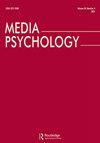“让你的拇指休息一下”从冲浪悲剧帖子:社交媒体用户的末日滚动的潜在腐蚀性后果
IF 2.6
2区 心理学
Q1 COMMUNICATION
引用次数: 2
摘要
消极偏见预测个体会关注、学习负面新闻,并优先考虑负面新闻多于正面新闻。根据成瘾成分模型,这项横断面研究将“末日滚动”概念化并衡量为与社交媒体平台上负面新闻消费相关的过度想法、冲动或行为。参与者是伊朗社交媒体用户的方便样本(N = 747)。8项单维度社交媒体末日滚动量表显示出出色的心理测量特性。男性比女性更有可能报告世界末日。大多数受访者表示,在末日滚动之后会感到兴奋。“末日卷轴”与心理健康、生活满意度和避免不健康行为的动机呈负相关。“末日卷轴”与冲动、冒险行为、抑郁和未来焦虑呈正相关。研究结果表明,“末日幻想”是一种令人兴奋的活动,有可能加剧对未来的担忧,滋生绝望感,培养冒险欲望,扼杀健康意识。本文章由计算机程序翻译,如有差异,请以英文原文为准。
“Give Your Thumb a Break” from Surfing Tragic Posts: Potential Corrosive Consequences of Social Media Users’ Doomscrolling
ABSTRACT Negativity bias predicts that individuals will attend to, learn from, and prioritize negative news more than positive news. Drawing from the addiction components model, this cross-sectional study conceptualized and measured “doomscrolling” as excessive thoughts, urges, or behaviors related to the consumption of negative news on social media platforms. Participants were a convenience sample (N = 747) of Iranian social media users. The 8-item, unidimensional Social Media Doomscrolling Scale showed excellent psychometric properties. Men were more likely than women to report doomscrolling. Most respondents reported arousal following doomscrolling. Doomscrolling was negatively associated with psychological wellbeing, satisfaction with life, and motivation to avoid unhealthy behaviors. Doomscrolling was positively associated to impulsivity, engagement in risky behaviors, depression, and future anxiety. Results suggest that doomscrolling is an arousing activity that has the potential to exacerbate worrisome thoughts about future, breed feelings of hopelessness, cultivate appetite for risk, and stifle health consciousness.
求助全文
通过发布文献求助,成功后即可免费获取论文全文。
去求助
来源期刊

Media Psychology
Multiple-
CiteScore
8.60
自引率
7.10%
发文量
30
期刊介绍:
Media Psychology is an interdisciplinary journal devoted to publishing theoretically-oriented empirical research that is at the intersection of psychology and media communication. These topics include media uses, processes, and effects. Such research is already well represented in mainstream journals in psychology and communication, but its publication is dispersed across many sources. Therefore, scholars working on common issues and problems in various disciplines often cannot fully utilize the contributions of kindred spirits in cognate disciplines.
 求助内容:
求助内容: 应助结果提醒方式:
应助结果提醒方式:


